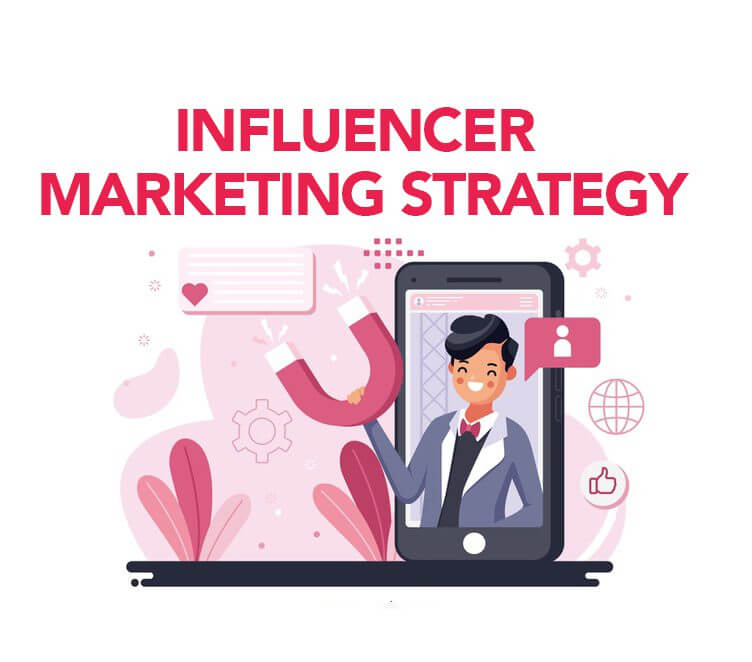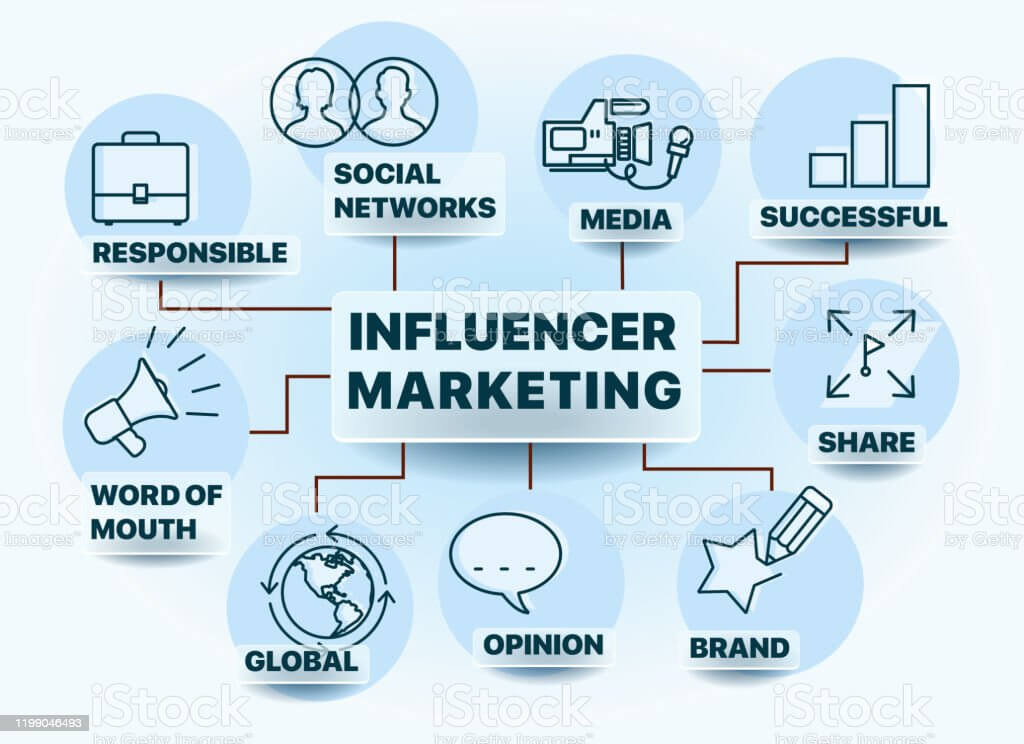Influencer Marketing
Introduction
In today’s digital age, influencer marketing has emerged as a powerful marketing strategy utilized by businesses of all sizes and industries. With the rise of social media platforms and the growth of online audiences, influencer marketing has become an effective way for brands to reach and engage with their target audiences. This article will explore influencer marketing, its benefits, and types, creating an influencer marketing campaign, best practices, and the latest trends and predictions in influencer marketing.
What is Influencer Marketing?
Influencer marketing is a marketing strategy that involves partnering with individuals with a large social media following or a solid online presence to promote a brand’s products or services. Influencers can be celebrities, industry experts, bloggers, or people with a significant following on social media platforms such as Instagram, TikTok, and YouTube. Influencer marketing is based on the idea that people trust recommendations from people they know, like, and trust, and influencers can help brands leverage this trust to reach and engage with their target audiences.
The Role of Influencer Marketing in Today’s Marketing Landscape
Consumers are bombarded with advertisements and marketing messages daily in today’s marketing landscape. As a result, traditional marketing strategies such as TV and print ads have become less effective in capturing consumers’ attention. Influencer marketing, on the other hand, has emerged as a more effective marketing strategy for reaching and engaging with consumers. Influencer marketing allows brands to reach their target audiences more authentically and meaningfully. Influencers can promote products and services in a way that feels more natural and less intrusive than traditional advertising.
Why is Influencer Marketing Effective?
There are several reasons why influencer marketing is effective. Firstly, influencers have built a loyal following of people who trust their opinions and recommendations. By partnering with influencers, brands can leverage this trust to reach and engage their target audiences. Secondly, influencers can create content that resonates with their followers, which can help brands to build brand awareness and generate buzz around their products or services. Finally, influencer marketing is cost-effective compared to traditional marketing strategies, allowing brands to reach a large audience with a relatively small budget.
The Benefits of Influencer Marketing
Influencer marketing has become an increasingly popular strategy for brands of all sizes and industries. This marketing tactic involves partnering with individuals with a large social media following to promote a brand’s products or services. The influencers can be celebrities, industry experts, bloggers, or people who have gained a significant following on social media platforms like Instagram, TikTok, and YouTube. In this article, we will explore the benefits of influencers for businesses.
Building Trust and Credibility
One of the key benefits of marketing is the ability to build trust and credibility for your brand. Influencers have built a loyal following of people who trust their opinions and recommendations. By partnering with influencers, brands can leverage this trust and credibility to reach and engage their target audiences. This trust can be crucial for new or lesser-known brands looking to establish themselves in the marketplace.
Increasing Brand Awareness and Reach
Influencer marketing can help brands reach a wider audience and increase brand awareness. By partnering with influencers, brands can tap into the influencer’s existing following, which can help to expand their reach and visibility. Additionally, influencers can create content that resonates with their followers and promotes the brand’s products or services, which can help to generate buzz and increase brand awareness.
Driving Sales and Conversions
Influencer marketing can be an effective way to drive sales and conversions. Influencers can create content that promotes a brand’s products or services naturally and authentically. This type of content can be more effective than traditional advertising methods, as it feels less intrusive and more like a personal recommendation from someone the consumer knows and trusts. Additionally, many influencers provide their followers with exclusive discount codes or promotions, which can incentivize them to purchase.
Cost-Effective Marketing Strategy
Influencer marketing can be a cost-effective marketing strategy for brands. While partnering with celebrity influencers can be expensive, working with micro or nano-influencers can be much more affordable. These influencers may have a smaller following but have built a loyal and engaged audience in a specific niche. This can be especially effective for brands with a niche product or service, as they can reach a highly targeted audience with a relatively small budget.
Reaching Younger Audiences
Influencer marketing is especially effective at reaching younger audiences likelier to follow and engage with influencers on social media platforms. This demographic can be difficult to get through traditional marketing methods, but influencer marketing can be an effective way to engage with them. Studies have shown that 70% of teens trust influencers more than traditional celebrities.
Influencer marketing has become an effective marketing strategy for brands looking to build trust and credibility, increase brand awareness and reach, drive sales and conversions, and reach younger audiences. By partnering with the right influencers, brands can leverage the trust and credibility that influencers have built with their followers to reach and engage with their target audiences more authentically and meaningfully.
Types of Influencer Marketing
Influencer marketing has become a popular strategy for brands of all sizes and industries. This marketing tactic involves partnering with individuals with a large social media following to promote a brand’s products or services. Several influencers include celebrities, industry experts, bloggers, or people who have gained a significant following on social media platforms like Instagram, TikTok, and YouTube. In this article, we will explore the different types of influencer marketing.
Celebrity Endorsements
Celebrity endorsements are the most well-known type of influencer marketing. This involves partnering with a celebrity to promote a brand’s products or services. The celebrity’s large following can help to increase brand awareness and reach, and their endorsement can lend credibility to the brand. However, celebrity endorsements can be expensive, and it cannot be easy to ensure that the celebrity’s endorsement feels authentic and genuine.
Micro-Influencers
Micro-influencers have a smaller following (typically between 1,000 and 100,000 followers) and have a loyal following in a specific niche. These influencers can be highly effective for brands with a niche product or service, as they can reach a highly targeted audience. Additionally, micro-influencers tend to have higher engagement rates than more prominent influencers, as their followers often feel a closer connection to them.
Macro-Influencers
Macro-influencers have a larger following than micro-influencers (typically between 100,000 and 1 million followers). These influencers can be effective for brands looking to reach a larger audience while maintaining authenticity and engagement. Macro-influencers tend to have a more diverse following than micro-influencers, which can help increase brand awareness.
Nano-Influencers
Nano-influencers have a tiny following (typically between 500 and 5,000 followers) and build a loyal following in a specific niche. These influencers can be highly effective for brands with a small budget, as they often charge less for sponsored content. Additionally, nano-influencers tend to have very high engagement rates, as their followers often feel a close connection to them.
Mega-Influencers
Mega-influencers have a considerable following (typically over 1 million followers). These influencers can be effective for brands looking to reach a broad audience quickly. However, mega-influencers are expensive and may not feel as authentic or engaging as smaller influencers.
There are several types of influencer marketing, each with advantages and disadvantages. By choosing the right kind of influencer for your brand, you can effectively reach and engage with your target audience more authentically and meaningfully. Whether you work with a celebrity, micro-influencer, macro-influencer, nano-influencer, or mega-influencer, the key is ensuring the partnership feels authentic and genuine to the influencer and their followers.
Creating an Influencer Marketing Campaign
Influencer marketing has become an increasingly popular strategy for brands of all sizes and industries. This marketing tactic involves partnering with individuals with a large social media following to promote a brand’s products or services. To launch a successful influencer marketing campaign, there are several steps that brands must follow. This article will explore how to create an influencer marketing campaign.
Setting Goals and Objectives
The first step in creating an influencer marketing campaign is to set clear goals and objectives. These goals should align with the marketing strategy and be specific, measurable, and achievable. Examples of goals could include increasing brand awareness, driving sales and conversions, or building brand credibility.
Identifying the Right Influencers
Once goals and objectives have been established, the next step is identifying the right influencers to partner with. This involves researching to identify influencers whose audience aligns with the brand’s target demographic. Additionally, it is essential to consider factors such as the influencer’s engagement rate, authenticity, and value alignment.
Developing a Campaign Strategy
Once the right influencers have been identified, developing a campaign strategy is next. This should include a clear message that aligns with the brand’s overall marketing strategy and a plan for the type of content that will be created. It is essential to work closely with influencers to ensure that the content feels authentic and aligns with their brand.
Measuring Success
Finally, it is essential to measure the success of the influencer marketing campaign. This can be done by tracking key performance indicators (KPIs) such as engagement rate, reach, and conversions. By measuring success, brands can determine the ROI of the campaign and make adjustments as needed for future campaigns.
In addition to these critical steps, there are several best practices that brands should follow when creating an influencer marketing campaign. These include:
Ensuring Authenticity and Transparency: It is essential to ensure the influencer’s content feels authentic and transparent to their followers. This can be done by clearly labeling sponsored content and working closely with influencers to ensure it aligns with their brand.
Aligning with Influencers Whose Values Match Your Brand: Partnering with influencers aligning with your brand’s values is essential. This can help to build credibility and trust with the influencer’s audience.
Providing Clear Guidelines and Expectations: It is essential to provide clear guidelines and expectations for the influencer, including what types of content they should create and how the brand should be portrayed.
Monitoring and Measuring Performance: It is essential to monitor and measure the performance of the influencer marketing campaign to determine its effectiveness and make adjustments as needed.
Creating a successful influencer marketing campaign involves setting clear goals and objectives, identifying the right influencers, developing a campaign strategy, and measuring success. By following best practices such as ensuring authenticity and transparency, aligning with influencers whose values match your brand, providing clear guidelines and expectations, and monitoring and measuring performance, brands can launch effective influencer marketing campaigns that reach and engage with their target audience.
Influencer Marketing Best Practices
Influencer marketing has become a popular strategy for brands looking to reach and engage with their target audiences more authentically and meaningfully. This marketing tactic involves partnering with individuals with a large social media following to promote a brand’s products or services. To ensure the success of an influencer marketing campaign, there are several best practices that brands should follow. In this article, we will explore influencer marketing best practices.
Ensuring Authenticity and Transparency
One of the most critical influencer marketing best practices is to ensure authenticity and transparency. This means working closely with influencers to ensure their content feels authentic and aligns with their brand. Additionally, it is important to clearly label sponsored content to ensure transparency with the influencer’s followers.
Aligning with Influencers Whose Values Match Your Brand
Another critical best practice is to align with influencers who match your brand’s values. This can help to build credibility and trust with the influencer’s audience and can help to ensure that the content feels authentic and genuine.
Providing Clear Guidelines and Expectations
Clear guidelines and expectations ensure the influencer’s content aligns with the brand’s overall marketing strategy. This includes guiding the type of content that should be created and how the brand should be portrayed in the range.
Monitoring and Measuring Performance
It is essential to monitor and measure the performance of an influencer marketing campaign to determine its effectiveness and make adjustments as needed. This can be done by tracking key performance indicators (KPIs) such as engagement rate, reach, and conversions.
Maintaining Authenticity and Long-Term Relationships
To maintain authenticity and build long-term relationships with influencers, it is essential to treat influencers as partners rather than simply as a means to an end. This includes ongoing support and engagement and valuing the influencer’s input and feedback.
Influencer marketing can be an effective marketing strategy for brands looking to reach and engage with their target audience more authentically and meaningfully. By following best practices such as ensuring authenticity and transparency, aligning with influencers whose values match your brand, providing clear guidelines and expectations, monitoring and measuring performance, and maintaining authenticity and long-term relationships, brands can launch successful influencer marketing campaigns that resonate with their target audience and drive results.
Influencer Marketing Trends and Predictions
Influencer marketing has become an irregular marketing strategy for brands looking to reach and engage with their target audiences more authentically and meaningfully. Aevolvesinues to evolve, brands should be aware of several influencer marketing trends anThisctions. his article, we will explore the latest trends and forecasts in influencer marketing.
The Rise of Micro and Nano-Influencers
While celebrity influencers have traditionally been the go-to for influencer marketing campaigns, there has been a rise in the use of micro and nano-influencers. These influencers have a smaller following but tend to have a highly engaged and loyal audience. Additionally, working with micro and nano-influencers can be more cost-effective for brands.
Authenticity and Transparency Will Remain Key
Authenticity and transparency have always been important in influencer marketing, and this trend is expected to continue. Brands will need to work closely with influencers to ensure that sponsored content feels authentic and genuine and that any sponsored posts are clearly labeled to ensure transparency with the influencer’s followers.
Video Content Will Continue to Grow
Video content has become increasingly popular on social media platforms like Instagram, TikTok, and YouTube. Brands must consider incorporating video content into their influencer marketing campaigns to reach and engage with their target audience effectively.
The Rise of Influencer Marketplaces
As the influencer marketing industry continues to grow, there has been a rise in the use of influencer marketplaces. These marketplaces connect brands with influencers and can help streamline influencer marketing.
Influencer Marketing Will Be More Data-Driven
As the industry continues to mature, influencer marketing will become more data-driven. Brands will need to use data to measure the effectiveness of their influencer marketing campaigns and make adjustments as necessary to ensure that they are reaching and engaging with their target audience.
Increased Collaboration Between Brands and Influencers
As influencer marketing continues to evolve, there will be an increased focus on collaboration between brands and influencers. This includes influencers being involved in the creative process and working with brands to develop content that feels authentic and engaging to their audience.
Influencer marketing is an effective strategy for brands looking to reach and engage with their target audience more authentically and meaningfully. To stay ahead of the curve, brands should be aware of the latest trends and predictions in influencer marketing, including the rise of micro and nano-influencers, the importance of authenticity and transparency, the growth of video content, the rise of influencer marketplaces, the increased focus on data-driven influencer marketing, and the importance of collaboration between brands and influencers. By incorporating these trends and predictions into their influencer marketing strategy, brands can effectively reach and engage with their target audience and drive results.
Conclusion
Influencer marketing has become a popular strategy for brands looking to reach and engage with their target audiences more authentically and meaningfully. This marketing tactic involves partnering with individuals with a large social media following to promote a brand’s products or services.
In this article, we have explored the different types of influencer marketing, including celebrity endorsements, micro-influencers, macro-influencers, nano-influencers, and mega-influencers. We have also covered the critical steps in creating an influencer marketing campaign, including setting goals and objectives, identifying the right influencers, developing a campaign strategy, and measuring success.
Additionally, we have discussed influencer marketing best practices, including ensuring authenticity and transparency, aligning with influencers whose values match your brand, providing clear guidelines and expectations, monitoring and measuring performance, and maintaining authenticity and long-term relationships.
Finally, we have explored the latest influencer marketing trends and predictions, including the rise of micro and nano-influencers, the importance of authenticity and transparency, the growth of video content, the rise of influencer marketplaces, the increased focus on data-driven influencer marketing, and the importance of collaboration between brands and influencers.
Influencer marketing is an effective strategy for brands looking to reach and engage with their target audience more authentically and meaningfully. By following best practices and staying aware of the latest trends and predictions in the industry, brands can effectively launch influencer marketing campaigns that drive results and build brand awareness and credibility.
F.A.Q
What are the four types of influencer marketing?
The four types of influencer marketing are:
- Celebrity Endorsements: This type of influencer marketing involves partnering with a celebrity or public figure to promote a brand’s products or services.
- Macro-Influencers: Macro-influencers have a large social media following, typically between 100,000 and 1 million followers. Brands often use these influencers to promote their products or services to a large audience.
- Micro-Influencers: Micro-influencers have a smaller social media following, typically between 1,000 and 100,000 followers. These influencers have a highly engaged and loyal audience often used by brands to promote niche products or services.
- Nano-Influencers: Nano-influencers have a minimal social media following, typically less than 1,000 followers. These influencers often have a highly engaged and loyal audience within a specific community or niche. Brands often use them to promote products or services to a particular audience.
How successful is influencer marketing?
Influencer marketing is a successful marketing strategy for many brands. According to a survey conducted by Influencer Marketing Hub, 89% of marketers found influencer marketing compelling. Additionally, a study by Linqia found that 39% of marketers plan to increase their influencer marketing budget in 2021.
One reason for the success of influencer marketing is its ability to reach and engage with a highly targeted audience. By partnering with influencers whose audience aligns with the brand’s target demographic, brands can effectively reach their ideal customer and drive sales and conversions.
Influencer marketing also can build trust and credibility with the influencer’s audience. This is especially true when influencers create authentic and genuine content that aligns with their brand and values and when sponsored content is clearly labeled to ensure transparency.
Overall, the success of influencer marketing will depend on several factors, including the brand’s goals and objectives, the influencer’s audience and engagement rate, and the authenticity and transparency of the sponsored content. When done correctly, influencer marketing can be an effective marketing strategy for brands looking to reach and engage with their target audience more authentically and meaningfully.







